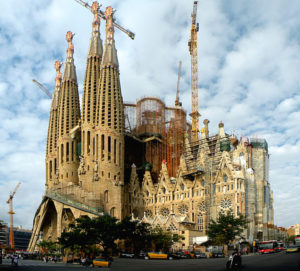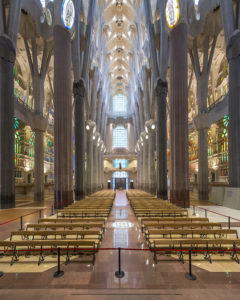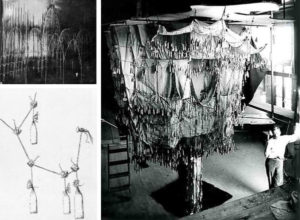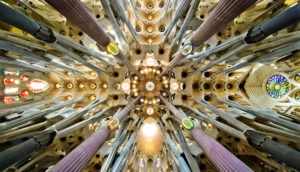
Exterior of the Sagrada Familia
When talking about unfinished projects, like the creative prompt from last week, who better to talk about than Antoni Gaudi and the Sagrada Familia. Antoni Gaudi (1852-1926) was a Catalan architect best known for his unfinished work Basílica i Temple Expiatori de la Sagrada Família, often shortened to Sagrada Familia, in Barcelona, Spain. Gaudi was put in charge of La Sagrada Familia shortly after construction began and remained the architect until his death in 1926. Today, the Sagrada Familia still remains unfinished.

Interior of the Sagrada Familia
Devoutly Catholic, Gaudi’s design for the church that was deeply influenced by his faith. Geometry was important to the Catholic church, as it symbolized the order of the world under God. While Gaudi pulls his geomotry from neo-Gothic architecture of the time, he creates his own style of organic geometry, where it almost feels like the concrete structures are going to come alive and move upwards, towards heaven. Gaudi often uses forms that look organic for columns and arches, as if they are stretched like a web. Gaudi’s goal was to create the feeling of heaven on earth when entering the church. All the forms in the interior, while certainly drawing from neo-Gothic architecture of the time in their arches and columns, also pulled from Art Nouveau and nature to create the sense of upward movement and growth, as if to heaven.

Gaudi’s models
Part of the way Gaudi was able to achieve such incredible forms in La Sagadra Familia was how he modeled his designs. Gaudi preferred modeling buildings to drawing them. He used chains and strings hung from the ceiling to model curves and forms that, when turned upside down, would transform into arches. In modeling architecture this way, he was able to produce catenary curves, which is a curve that evenly distributes the weight. When this curve is flipped over to form an arch, it similarly distributes the weight. While this method for modeling weight distribution was already known, Gaudi was able to model for asymmetrical architecture, allowing him to create the fluid and organic shapes seen throughout the Sagrada Familia.

Ceiling of the nave of Sagrada Familia
The Sagrada Familia has been a work in progress ever since Gaudi’s death in 1926. At the time of his death, it was only about a quarter finished. Gaudi left elaborate models in plaster with plans for the church, but almost all of them were destroyed during the Spanish Civil War. Though it was consecrated in 2010 by Pope Benedict XVI, currently La Sagrada Familia is only about half completed, and has been under construction for 138 years. Architects and designers are continuing to build and construct the Sagrada Familia, adhering to Gaudi’s vision as much as possilbe, and perhaps one day we will see it completed.
Bibliography
Gomez-Moriana, Raphael. “Gaudi’s hanging chain models: parametric design avant la lettre?” Criticalista. Raphael Gomez-Moriana, August 16, 2012. https://criticalista.com/2012/08/16/gaudis-hanging-chain-models-parametric-design-avant-la-lettre/.
Harris, Beth, and Steven Zucker. “Antoni Gaudi, Sagrada Familia.” Smarthistory. Smarthistory, August 9, 2015. https://smarthistory.org/gaudi-sagrada-familia/.
Mingle, Katie. “La Sagrada Familia.” 99% Invisible. Podcast audio, October 24, 2017. https://99percentinvisible.org/episode/la-sagrada-familia/.
Minder, Raphael. “Polishing Gaudi’s Unfinished Jewel.” The New York Times. The New York Times Company, November 3, 2010. https://www.nytimes.com/2010/11/04/arts/04iht-sacred.html.
Zucker, Steven, and Beth Harris. “Gaudi, Sagrada Familia.” Khan Academy. Khan Academy, January 29, 2011. https://www.khanacademy.org/humanities/becoming-modern/symbolism-artnouveau/symbolism-art-nouveau-spain/v/gaud-church-of-the-sagrada-fam-lia-1882-consecrated-2010-still-under-construction.
Latest posts by Metalwerx (see all)
- You helped make this year amazing! - November 29, 2021
- Announcing our Commitment to Continue In-Person AND Virtual Classes! - September 22, 2021
- Big Plans for Shopping Small for the Holidays - November 24, 2020
